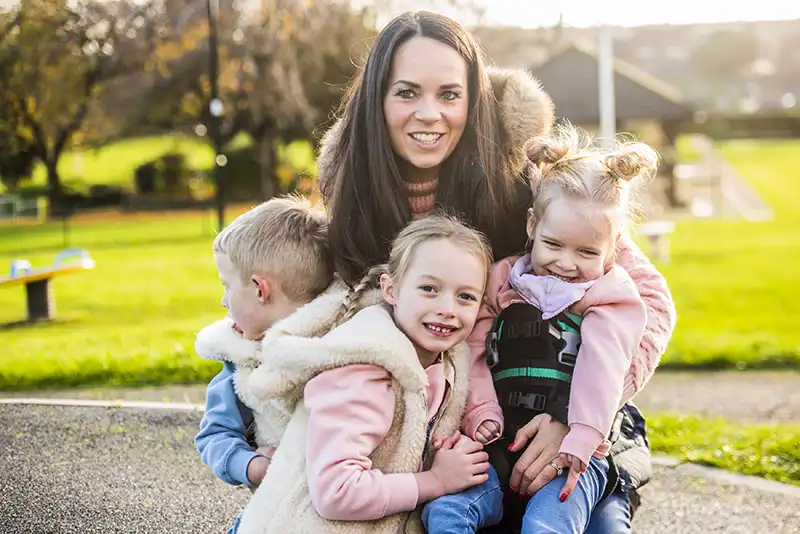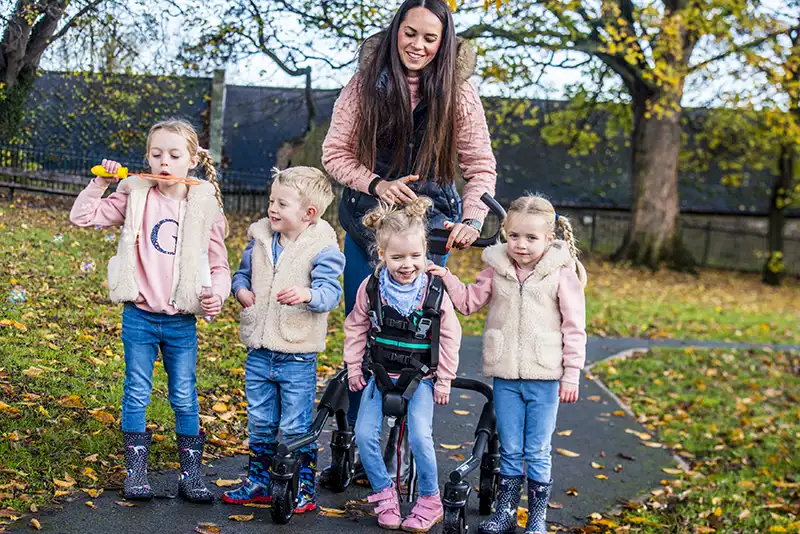I recently started to think about how the standard care of children with neuromuscular conditions, Spinal Muscular Atrophy (SMA) in particular, has changed in such a short space of time.
SMA is a genetic condition that affects the group of nerve cells that carries information from the spinal cord to the muscles (lower motor neurons). The information from these nerves helps our muscles with purposeful movements that allow us to develop skills such as rolling, sitting, and walking, as well as enabling basic bodily functions like breathing and swallowing.
SMA is caused by a mutation in a gene called Survival Motor Neuron 1 (SMN1). We have two copies of this gene, one from each parent. The SMN1 is the primary gene that is responsible for making the protein SMN, which is needed to keep the lower motor neurons functioning well.
We also have a secondary gene, SMN2, which can make some SMN protein (approximately 10%1), but not enough to keep the lower motor neurons working effectively. People with SMA have faults in both copies of their SMN1 gene. Their SMN2 gene is unable to make enough SMN to compensate, which then causes deterioration to the lower motor neurons, which eventually leads to muscle weakness.

When I specialized in pediatrics in 2014, there were limited treatments available, and families were not given much hope for the future. Physiotherapy and Occupational Therapy interventions were focused on skill maintenance rather than skill progression, as well as management of secondary complications that were likely to arise. It was often tricky to strike a balance between encouraging children to be as active as possible, whilst still enabling them to be functional within their home and school environment. Fast forward to 2023 and three new treatments are available, with varying inclusion and exclusion criteria, in lots of countries around the world.
Nuisnersen (brand name: Spinraza) was the first drug to be made available for children with SMA. Spinraza works by increasing the amount of SMN that the SMN2 gene can produce, and therefore helps to reduce the deterioration of the lower motor neurons. It is given via an injection directly into the spinal cord and, after the initial loading doses, it is given at four-month intervals.
Risdiplam (brand name: Evrysdi) is the most recently approved treatment for SMA and it works in the same way as Spinraza, increasing the production of functional SMN from the SMN2 gene, but it is taken daily in liquid form. Trials for both of these treatments have shown improved muscle formation when tested using standardized outcome measures.2,3
The other approved treatment for SMA is Onasemnogene Abeparvovec (brand name: Zolgensma). Zolgensma works differently than the previous two treatments as it is a gene therapy. This means that it delivers a healthy copy of the SMN1 gene into the body, so that it can produce enough SMN to keep the lower motor neurons healthy. It is given via a one-off injection straight into the bloodstream. This treatment has been found to be more effective for children with SMA Type 1 (the most severe form of SMA) and, additionally, most effective when it is administered early in the child's life.4
These treatments, combined with an increased drive to have newborn screening for SMA, have the potential to completely transform the future of individuals living with the condition. They have also increased the opportunities for children to have access to adaptive equipment and enhance their quality of life.

I have had the privilege of working with some fantastic children with SMA throughout the years, but I recently completed a Leckey MyWay+ assessment with a 5-year-old girl with SMA Type 1 who had received Spinraza and Zolgensma treatment at a very young age. I was amazed to see her come into the room in a low support manual wheelchair and then to stand with some support from her mom and shifting her weight independently.
She was able to use the MyWay+ independently and walk around the room fetching toy food from her pretend shop. Seeing her talk and laugh with her mom and take herself where she wanted to go really hit home to me about what an exciting time it is to be working with children with SMA and how adaptive equipment can really help children with SMA live their lives to the fullest.
References
- Lorson CL, Rindt H, Shababi M (2010) Spinal muscular atrophy: mechanisms and therapeutic strategies. Hum Mol Genet 19: R111-R118
- Albrechtsen, S. S., Born, A. P., & Boesen, M. S. (2020). Nusinersen treatment of spinal muscular atrophy-a systematic review. Dan Med J, 67(9), A02200100.
- Paik, J. (2022). Risdiplam: a review in spinal muscular atrophy. CNS drugs, 36(4), 401-410.
- Lowes, L. P., Alfano, L. N., Arnold, W. D., Shell, R., Prior, T. W., McColly, M., ... & Mendell, J. (2019). Impact of age and motor function in a phase 1/2A study of infants with SMA type 1 receiving single-dose gene replacement therapy. Pediatric neurology, 98, 39-45.
Rebekah Moynihan graduated from the University of Nottingham in 2012 with a degree in Physiotherapy. She completed her junior rotations in both adult and children's physiotherapy in Nottinghamshire County before specializing as a Pediatric Physiotherapist in 2014.
Rebekah has a special interest in neuromuscular conditions and also the management of hip displacement in children with Cerebral Palsy.